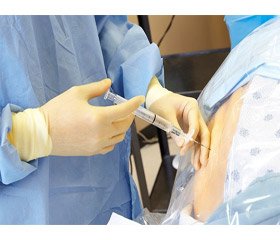Журнал «Медицина неотложных состояний» 1 (64) 2015
Вернуться к номеру
Features of epidural anesthesia for endovascular embolization of the uterine arteries
Авторы: Dziuba D.A., Nedashkivskyi S.M., Galushko A.A., Vereschagin S.V.
Рубрики: Медицина неотложных состояний
Разделы: Клинические исследования
Версия для печати
A hysteromyoma is one of the most common benign tumors of the pelvic organs in women, which is formed from smooth muscle cells of the myometrium. In women of reproductive age incidence is 15-30%, and for women in the perimenopausal period - up to 50-70%.
In treatment of this disease one of the most promising and modern surgical approaches is embolization of uterine arteries. For almost 30 years, this method is used in the practice of Obstetricians and Gynecologists. Uterine artery embolization incorporated in 2003 to the Ministry of Health of Ukraine clinical protocols. More than 90% of patients after this mini-invasive surgery, mark the complete disappearance or significant improvement of gynecological symptoms.
However, the current method has its drawbacks. First of all, a complication associated with angiographic technique: allergic reactions, formation of local hematoma, infection complications. The most common occurrence in the early postoperative period is the development of the so-called afterembolisation syndrome. He has such manifestations as short-term hyperthermia, bleeding, nausea. However, one of the most unpleasant manifestations of this syndrome is intensive postoperative pain. Main treat method is administration of narcotic analgesics and NSAIDs. But given the intensity of pain now frequently used method of epidural anesthesia / analgesia (EA) as one of the most effective methods for its prevention and treatment. However, the effectiveness of this method of anesthesia may be insufficient due to incomplete blockade of sacral segments. Given this, it becomes appropriate to use the caudal anesthesia (CA), which is a type of epidural anesthesia.
Objective. Determine the effectiveness of traditional methods of anesthesia, epidural anesthesia / analgesia bupivacaine and combined caudal anesthesia / analgesia with bupivacaine buprenofinom in patients after endovascular embolization of uterine artery.
Materials and methods. The investigation held in Kyiv regional hospital and includes 29 women, who were randomly divided into three groups. All patients performed uterine artery embolization on uterine fibroids. For postoperative analgesia using ketorolac at a dose of 30 mg every 8 hours, and when expressed pain (by PS> 3 points) additionally administered 20 mg omnopon parenterally. Patients first experimental group, in preparation for surgical interference, performed epidural anesthesia at L2-L3 and administered 0.125% bupivacaine solution in a volume of 25 ml every 8 hours (n = 9). Patients of II experimental group for 30 minutes before surgery performed caudal anesthesia on its own method in the "on the side" of 0.125% bupivacaine combined with 0.12 mg of buprenorphine in the volume of 40 ml (n = 10). The control group III consisted patients that epidural analgesia is not performed (n = 10).
The intensity of pain was evaluated by the numerical pain rating scale (PS) pain from 0 to 10 points. The evaluation was performed, after 1, 3, 8, 24 and 48 hours after surgery.
Profile analgesia in patients undergoing epidural blockade, significantly different from the control group. Thus, in patients group, which served patients as EA and CA, the level of pain PS in time intervals from the first to the third hour after surgery was significantly more than three times than women in the control group. After 8 hours difference was significantly more than 2 times, but after 24 hours no significant difference was noted.
As for the heart rate, the significantly lower values for parameters were as in I and II in experimental groups during the first postoperative day, which correlates with the pattern of pain.
It should also be noted that the second postoperative day in and group needs epidural anesthesia was not in 66% of patients, and on the third day of the epidural catheter was removed 100% of patients.
Sick as I and II experimental group did not require the introduction of opioids in the control group and 80% of patients received an additional lump of narcotic analgesics, 75% of them – twice. Patients and II of the maximum level of postoperative pain did not exceed 3 points by PS, while in control - the highest level reached by PS 7 points.
Conclusions.
1. The use of postoperative analgesia through the use of non-steroidal analgesics, if necessary with the addition of opiates does not provide a sufficient level of postoperative pain.
2. The use of epidural analgesia compared with routine postoperative analgesia provides an adequate level of analgesia after uterine artery embolization.

